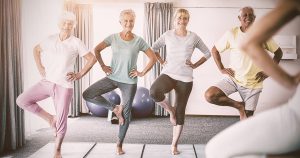 Lately I’ve seen more than a couple of very fit, good-looking senior men in dance, yoga, and Pilates studios. They may be trendsetters who are so secure in their masculinity that they’re not afraid to try out new moves. (At least I don’t think they are there to pick up senior chicks, but then again…)
Lately I’ve seen more than a couple of very fit, good-looking senior men in dance, yoga, and Pilates studios. They may be trendsetters who are so secure in their masculinity that they’re not afraid to try out new moves. (At least I don’t think they are there to pick up senior chicks, but then again…)
Yoga studios have popped up everywhere, but what do seniors need to know about yoga as it is suitable for senior bodies?
Yoga for Seniors
Savvy women have been doing yoga forever, and the popularity of yoga keeps growing. For both men and women, yoga is usually offered in group classes with professional instructors to guide you. According to the U.S. National Institute of Aging, not all yoga is safe for everyone: “Start with an appropriate yoga class—such as one called Gentle Yoga or Senior Yoga—in order to get individualized advice and learn correct form.” Aim to improve your flexibility, balance, breathing, and strength.
Restorative Yoga
Restorative yoga is a sequence of only five or six poses, and allows you to rest and relax with props (chairs, cushions, etc.) Each pose is held for five minutes or more, and may include light twists and bends. Most restorative practices are based on the teachings of B.K.S. Iyengar, who created his practice from the study of Hatha Yoga. At the age of 90, he continued to practice asanas (poses) for 3 hours and pranayamas (breathing exercises) for an hour daily. Not bad for someone who was described as a stiff, sickly teenager who would not be successful at yoga!
Hatha Yoga
Hatha Yoga originated in south Asia, and integrates ideas of ethics, diet, cleansing, pranayama (breathing exercises), meditation and a system for spiritual development of the yogi (student or practitioner of yoga.) Early text descriptions date back to the 11th Century. The best known and most widely used is Hatha Yoga Pradipika. It consists of four chapters:
- Poses/Postures (Asanas) as well as setting the proper environment for yoga and ethical duties of a yogi (student or practitioner of yoga)
- Breathing exercises (Pranayama) and body cleansing (satkarmani)
- Internalized energetic practices (Mudras)
- Meditation (Samadhi)
Most of today’s western culture Hatha Yoga classes focus on the physical techniques of poses and breathing.
Gentle Yoga/Senior Yoga
Gentle yoga, or Senior Yoga, is typically designed for beginners or those recovering from injuries, and offers safe pose modifications tailored for the student. In fact, some studies show you can reduce arthritis-related pain, improve joint function, build strength and promote relaxation through yoga.
According to The Arthritis Foundation, “people with arthritis, who need regular physical activity to keep joints flexible, maintain muscle tone and manage weight, may find yoga a perfect way to exercise. The gentle, flowing poses can be less stressful on sore joints than other types of movement.”
Gentle yoga promotes the flow of synovial fluid, which nourishes joint cartilage and allows smooth movement of the bones. And, new research shows yoga may be just as beneficial as physical therapy for some people with back pain.
“Anybody can benefit from yoga,” advises Colleen Pelkey, a Mayo Clinic mind and body instructor.
With practice, you can use yoga for relieving stress because it uses deep breathing with soothing music. The instructors gently guide you to achieve correct posture for the poses. You just show up with comfortable clothes and socks (some classes will require that you bring your own mat), and follow their lead.
I advise seniors to avoid hot yoga classes that can raise your internal temperature and blood pressure. You risk over-exhaustion, muscle injury and cartilage and tissue damage. If you’re considering it, consult with your doctor before taking a class.
Done you learn to do it correctly, you can improve the mind body connection, and strengthening your core—the key part of your body work out.
Balance Ball
If you’re not ready for a yoga class, try a balance ball and use it for sit-ups, back, and core exercises. I’ve found that sitting or lying over a balance ball is the most comfortable way to do sit-ups. It’s easier on your back and you get a full range of motion for your abdominal muscles.
When you work your core, you end up using all your other muscles, especially legs, hips, and back. This is essential to prevent falls and accidents. And by strengthening your core musculature (all the way around your torso) you strengthen your back and abdominals, have better posture, and look better!

Recent Comments